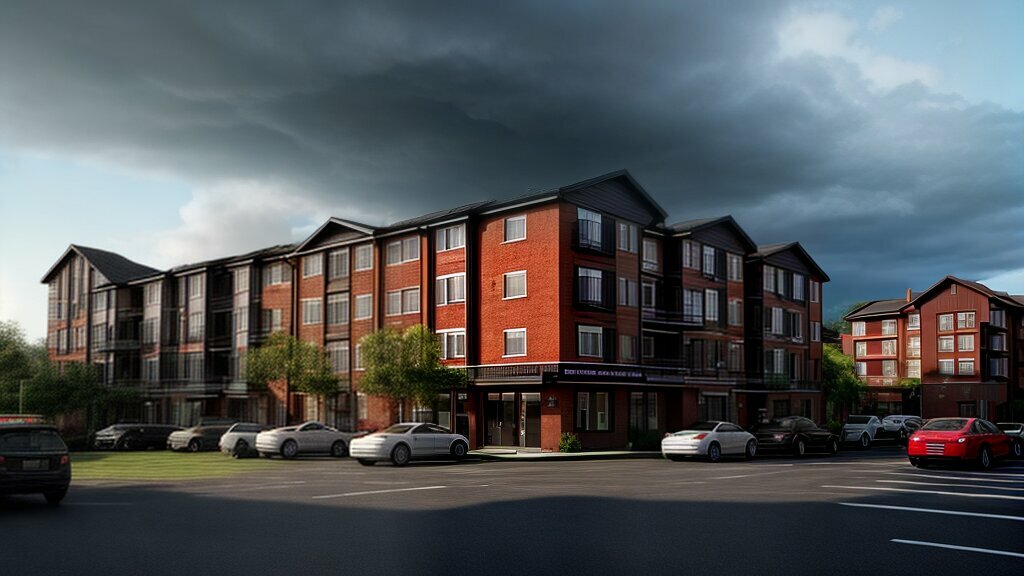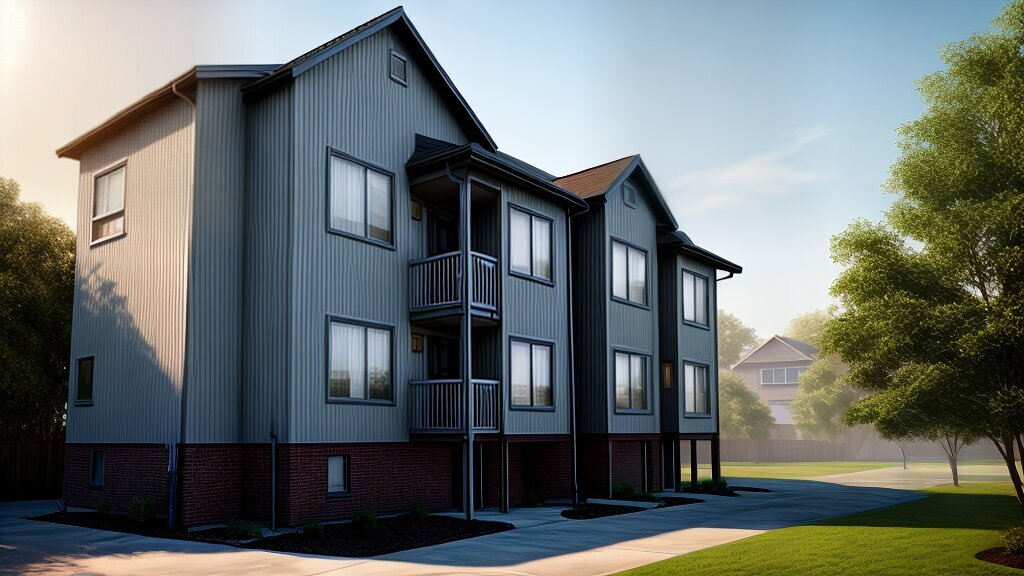Top Block of Flats Insurance Pitfalls

Terms to Know
Before selecting a block of flats insurance policy, it is important to know the different terms associated with this type of coverage. Here are some of the most relevant terms:
Term
Definition
Buildings Insurance
Covers damages to the structure of the building, including fixtures and fittings. Can also cover the cost of debris removal, architects, and surveyors fees.
Contents Insurance
Covers the contents of the property, such as furniture, appliances, and electronics.
Landlord Liability Insurance
Covers legal expenses related to injuries or property damage suffered by a third party on your property.
Excess
The amount you must pay towards any claim you make before your insurer covers the rest.
Premium
The amount you pay for your insurance policy. This can be paid in monthly, quarterly, or annual instalments.
Understanding these terms can help you make informed decisions when selecting a block of flats insurance policy.
In the next section, we will discuss the factors to consider when selecting the right insurance policy for your block of flats.
Selecting the Right Block of Flats Insurance
Choosing the right block of flats insurance policy is crucial for ensuring adequate coverage. There are several factors to consider before making your decision:
Factors to Consider
Explanation
Size of the Building
The size of the building will determine the cost of the insurance policy. Larger buildings will require more coverage and thus, a higher premium.
Location
The location of the block of flats is a significant factor to consider. Areas with high crime rates or prone to natural disasters may require additional coverage.
Specific Risks Associated with Flats
Flats with specific risks, such as those with balconies, lifts, or communal areas, may require additional coverage to account for potential accidents or damages.
It is important to note that the cheapest insurance policy may not always be the best option. Ensure that you have adequate coverage for your property by assessing your individual needs and risks.

Image Description: Selecting the Right Block of Flats Insurance pitfalls
Pitfall 4: Ignoring Building Regulations Compliance
Ensuring that your block of flats meets all building regulations is not only a legal requirement, but it can also impact your insurance coverage. If your building does not comply with regulations and an incident occurs, your insurance provider may deny your claim.
Building regulations cover a wide range of requirements, including fire safety, structural integrity, and accessibility. It is important to review and understand these regulations and ensure that your building adheres to them.
Regular inspections and maintenance can help ensure compliance and prevent any issues that may arise from non-compliance. Additionally, if you plan to make any modifications to your property, it is crucial to obtain the necessary permits and ensure that the changes comply with building regulations.

By ensuring that your building complies with building regulations, you can protect your investment and ensure that your insurance coverage is adequate in the event of an incident.
Pitfall 1: Underinsuring Your Property
One of the most common block of flats insurance pitfalls is underinsuring your property. This mistake can have serious consequences, leaving you with insufficient coverage to rebuild or repair your flats in the event of damage or loss.
It is important to accurately assess the value of your property and ensure that your insurance policy covers the full cost of rebuilding, including any associated costs such as demolition and professional fees. If your property is underinsured, your insurance payout may not be enough to cover the full cost of repairs or rebuilding.
Tip: Consider using a professional valuer to determine the correct rebuild value of your property. This will ensure that you have adequate coverage and avoid the pitfall of underinsurance.

“Underinsuring your property can have serious consequences, leaving you with insufficient coverage to rebuild or repair your flats in the event of damage or loss.”
Pitfall 2: Exclusion Gaps in Coverage
One of the most significant block of flats insurance pitfalls to watch out for is exclusion gaps in coverage. These gaps can leave your property vulnerable to losses, even if you have insurance. Basically, an exclusion gap is an area that is not covered by your policy. The result is that you may be left to cover the costs of any damages or losses that occur in that area.
Exclusion gaps can occur for various reasons. For example, some policies may exclude coverage for certain types of damage or losses, such as those caused by flooding or earthquakes. Other policies may exclude coverage for certain types of tenants, such as students or those on housing benefit. It is essential to understand what exclusions are in your policy and how they could affect your coverage.
To avoid exclusion gaps, you should carefully review your policy documents. Look for any exclusions or limitations in coverage, and make sure you understand what they mean. If you have questions, contact your insurer or broker for clarification. Consider supplementing your policy with additional coverage, such as flood insurance or landlord liability insurance, to fill any gaps in your coverage.
Being aware of exclusion gaps in coverage can help you avoid potential losses and ensure that your investment is adequately protected. By understanding your policy and supplementing it as needed, you can have peace of mind knowing that your block of flats is secure.

Pitfall 3: Improper Assessment of Risks
One of the most significant block of flats insurance pitfalls is failing to conduct a thorough risk assessment. Properly assessing the risks associated with your building is crucial for ensuring adequate coverage. Without a comprehensive risk assessment, you could be left with gaps in your insurance coverage, leaving your building vulnerable in the event of a disaster.
Conducting a risk assessment involves identifying potential risks such as fire, theft, water damage, and natural disasters. Once you have identified the risks, you can implement measures to mitigate them and reduce the likelihood of a claim. This can include installing smoke alarms, security cameras, and fire extinguishers, as well as making any necessary repairs to the building.
By conducting a thorough risk assessment and implementing necessary measures, you can avoid potential pitfalls and ensure that your block of flats insurance policy provides sufficient coverage.

Pitfall 4: Ignoring Building Regulations Compliance
One of the common block of flats insurance pitfalls is ignoring building regulations compliance. It is important to ensure your property meets all necessary regulations as non-compliance can impact your insurance coverage. Building regulations compliance is crucial to ensure the safety and well-being of your tenants.
When it comes to insurance coverage, non-compliance can lead to denied claims and expensive legal battles. Insurance providers require that your property complies with all relevant building regulations, failing which your claim may be rejected. This situation can be avoided by ensuring that your property has all necessary certifications and is up-to-date with all building regulations.
A common problem is that some property owners overlook the importance of complying with building regulations or assume that their building is already compliant. To avoid this pitfall, ensure that your property is inspected regularly and that all necessary permits and certifications are obtained. This includes fire safety, Gas Safety, Electrical Safety certificates, and more.

“Non-compliance can lead to denied claims and expensive legal battles”
Pitfall 5: Inadequate Liability Coverage
Having inadequate liability coverage is a potential pitfall property owners should be aware of when it comes to block of flats insurance. Liability coverage is essential in the event that someone is injured while on your property and holds you liable. Without sufficient coverage, you could be held responsible for the cost of medical bills and legal fees, which can be financially devastating.
To determine the appropriate amount of liability coverage for your block of flats, consider the size of the building, the number of occupants, and the specific risks associated with your property. Speak to your insurance provider to ensure that you have the right amount of coverage to protect yourself and your investment.

“Without sufficient coverage, you could be held responsible for the cost of medical bills and legal fees, which can be financially devastating.”
Pitfall 6: Incorrect Valuation of Property
Valuing your property correctly is vital for ensuring you have adequate coverage in the event of a claim. Incorrectly valuing your property can lead to underinsurance, which can have serious financial consequences.
When determining the value of your property, it’s important to consider factors such as the age of the building, location, and any recent renovations or upgrades that may have been made. You should also take into account the cost of rebuilding the property in the event of a total loss.
Tip:
Consider hiring a professional valuer to ensure your property is correctly valued.
By valuing your property accurately, you can ensure that your coverage reflects the true value of your investment and avoid potential issues when filing a claim.

Remember: Accurately valuing your property is crucial for avoiding pitfall 6: Incorrect Valuation of Property.
Coverage Options for Block of Flats Insurance
When selecting block of flats insurance, it is important to understand the coverage options available to you. The right insurance policy will depend on the size and location of your property, as well as any specific risks associated with flats.
Some of the coverage options you may consider include:
Insurance Type
Description
Buildings Insurance
This insurance covers the structure of the building, including walls, roof, floors, and other permanent fixtures. It also covers damage from events such as fire, floods, and storms.
Contents Insurance
This insurance covers the contents inside the flats, including furniture, appliances, and personal belongings of tenants. It can also cover accidental damage to items caused by tenants.
Landlord Liability Insurance
This insurance protects landlords against legal claims made by tenants or visitors to the property who suffer injury or damages as a result of the landlord’s negligence. It can also cover legal costs and compensation awards.
It is important to note that these coverage options may not be included in a standard insurance policy, and you may need to add them as additional coverage. Consult with your insurance provider to determine which coverage options are best suited for your block of flats.

Conclusion
Investing in a block of flats is a significant undertaking, and protecting your investment is essential. By being aware of the potential pitfalls and taking steps to avoid them, you can ensure that your property is adequately covered.
Understanding the basics of block of flats insurance, selecting the right policy, and evaluating policies thoroughly are all crucial steps in protecting your investment. Additionally, avoiding common mistakes such as underinsuring your property, ignoring building regulations compliance, or having inadequate liability coverage can save you from significant financial losses.
Remember to always conduct a thorough risk assessment and accurately value your property to avoid issues when filing a claim. Exploring different coverage options like buildings insurance, contents insurance, and landlord liability insurance can also help to tailor your policy to your specific needs.
Protect Your Investment Today
Don’t let common insurance pitfalls jeopardize your block of flats investment. Use this guide to navigate the world of block of flats insurance and ensure your property is protected. If you’re unsure about what kind of coverage you need or how to evaluate policies, don’t hesitate to seek professional advice from a qualified insurance broker.
Remember, taking the time to understand your policy and ensure adequate coverage can save you from significant financial losses in the long run. Protect your investment today and enjoy peace of mind knowing that your block of flats is properly insured.
FAQ
Q: What are the most common pitfalls of block of flats insurance?
A: The most common pitfalls of block of flats insurance include underinsuring your property, exclusion gaps in coverage, improper assessment of risks, ignoring building regulations compliance, inadequate liability coverage, and incorrect valuation of property.
Q: What is block of flats insurance?
A: Block of flats insurance is a type of insurance specifically designed for property owners who own and rent out multiple flats within a building. It provides coverage for the building structure, contents, and liability.
Q: How do I select the right block of flats insurance?
A: When selecting block of flats insurance, consider factors such as the size of the building, location, and specific risks associated with flats. It is important to choose a policy that provides adequate coverage for your property.
Q: How do I evaluate block of flats insurance policies?
A: To evaluate block of flats insurance policies, compare coverage, exclusions, and pricing. Look for policies that offer comprehensive coverage, minimize exclusion gaps, and fit within your budget.
Q: What are the consequences of underinsuring my property?
A: Underinsuring your property can leave you financially vulnerable in the event of a claim. It may result in inadequate compensation for repairs, rebuilding, or replacement of damaged property.
Q: What are exclusion gaps in coverage?
A: Exclusion gaps in coverage refer to specific scenarios or risks that are not covered by your insurance policy. It is important to review your policy carefully to identify any potential gaps in coverage and address them accordingly.
Q: Why is proper assessment of risks important for block of flats insurance?
A: Properly assessing the risks associated with your block of flats helps ensure that you have adequate coverage. It allows you to identify potential hazards, implement necessary safety measures, and select a policy that mitigates those risks.
Q: Why is building regulations compliance important for block of flats insurance?
A: Building regulations compliance is crucial for block of flats insurance as non-compliance can impact your coverage. Insurance providers often require proof of compliance with building regulations to ensure the safety and integrity of the property.
Q: Why is adequate liability coverage important for block of flats insurance?
A: Adequate liability coverage is important for block of flats insurance to protect you from potential legal claims. It covers expenses related to injuries or damages caused to third parties due to your property, such as slip and fall accidents or property damage.
Q: Why is correct valuation of property important for block of flats insurance?
A: Correctly valuing your property is important for block of flats insurance as it ensures that you are adequately insured. Underestimating the value may result in insufficient coverage, while overestimating it can lead to higher premiums.
Q: What are the coverage options for block of flats insurance?
A: Coverage options for block of flats insurance typically include buildings insurance, contents insurance, and landlord liability insurance. These coverages protect the building structure, contents within the flats, and provide liability coverage for landlords, respectively.






